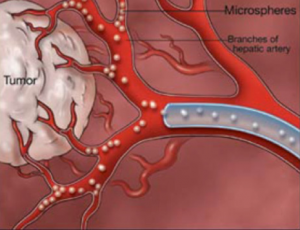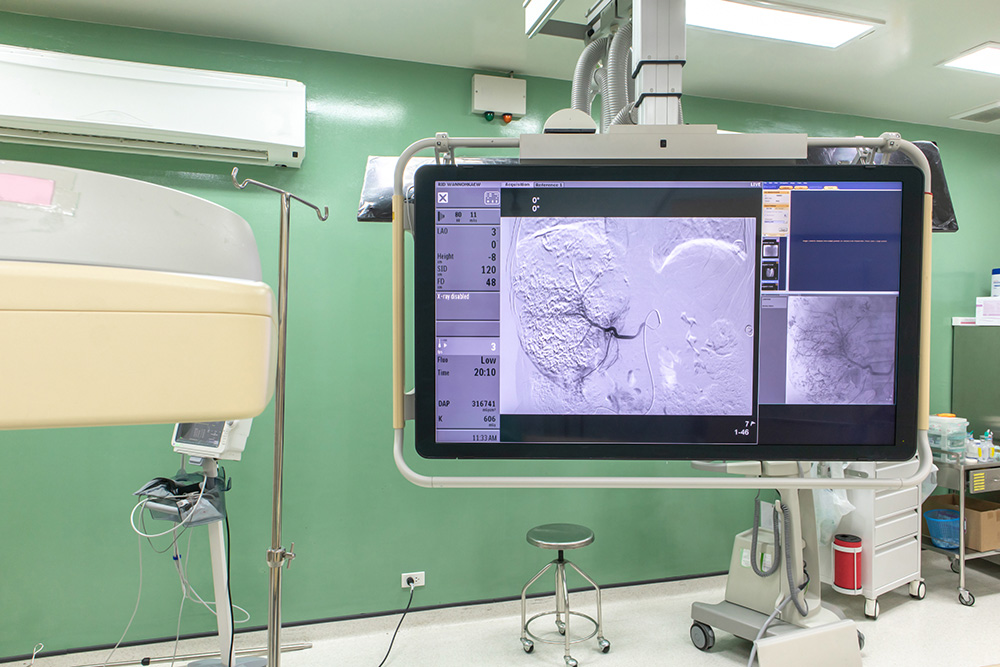What Is Transarterial Chemoembolization (TACE)?
Transarterial chemoembolization or (TACE) is a minimally invasive, image-guided treatment for liver cancer that combines the local delivery of chemotherapy with a procedure called embolization to treat liver cancer. It is a non-surgical procedure usually performed by an interventional radiologist, a specialty in medical imaging such as MRI, ultrasound, and more.
TACE is performed through a needle that is inserted into an artery in the groin or the wrist requiring a tiny incision, has fewer risks of complication, and take less recovery time than traditional surgery.
How Does the Procedure Work?
TACE attacks the cancer in two ways. First, it delivers a high concentration of chemotherapy directly into the tumor, without exposing the entire body to the effects of those drugs. Second, the procedure cuts off blood supply to the tumor, trapping the anti-cancer drugs at the site and depriving the tumor of the oxygen and nutrients it needs to grow.
The liver is unique because it has two blood supplies—the hepatic artery and the portal vein. The normal liver receives about 75 percent of its blood supply through the portal vein and only 25 percent through the hepatic artery. But when a tumor grows in the liver, it receives almost all of its blood supply from the hepatic artery.
Chemotherapy drugs injected into the hepatic artery reach the tumor directly, sparing most of the healthy liver tissue. Then, when the artery is blocked, the blood is no longer supplied to the tumor, while the liver continues to be supplied by blood from the portal vein. This also permits a higher concentration of the anti-cancer drugs to be in contact with the tumor for a longer period of time thereby maximizing the destruction of the tumor.
What to Expect During TACE

Benefits of TACE Treatment
Combining TACE with newer precision cancer medicines is a new treatment approach that bears promise. Data from numerous clinical trials have found that TACE significantly prolongs patients’ overall survival and improves their quality of life. In fact, TACE has been incorporated into all treatment guidelines for liver cancer.
Other benefits include:
- Increases the time to cancer progression
- Delays the potential to metastasize
- Can be combined with newer systemic treatments
The benefits of a TACE treatment typically last for an average of 10 to 14 months, depending on the type of tumor. The TACE treatment can be repeated if the cancer starts to grow again.
Other types of therapy (tumor ablation, chemotherapy, radiation) may be used in combination with TACE to control the tumor. This is all dependent on the size and location of the tumor.
Who is a Candidate for This Treatment?
Among the available therapies for liver cancer, TACE is by far the most widely utilized worldwide and is considered the first-line treatment recommended for patients with intermediate primary liver cancer or HCC.
Our specialists at USA Oncology Centers can help you decide whether this treatment is best suited for your condition. We work together with your oncology team to provide you with the most comprehensive and appropriate treatment.
What to Expect During Treatment
How to Prepare For Treatment
Several days before the procedure, you will have an office consultation with the interventional radiologist who will be performing your procedure.
Prior to your procedure, you will need several tests, including liver function blood tests, and a CAT scan or MRI of the liver.
During Your Procedure
This minimally-invasive treatment is performed in a comfortable outpatient setting. Devices to monitor your heart rate and blood pressure will be attached to your body. Angiography (X-ray based) images using contrast material will be taken to map the path of the blood vessels feeding the tumor. The procedure will be performed under conscious sedation whereby a light sedative will make you feel relaxed, sleepy and comfortable for the procedure. You may or may not remain awake, depending on how deeply you are sedated. The procedure is mostly painless. You may feel a slight pinch when the needle is inserted into the artery in the groin or wrist but every precaution will be taken to insure that the skin incision site will be numbed using local anesthetic as you would when you go to the dentist. You may feel minimal pressure when the catheter is inserted into the artery. However, you will not feel serious discomfort.
As described above, using x-ray guidance, a thin catheter will be inserted through the skin into an artery located in the groin or wrist and advanced into the liver. Then contrast material will then be injected through the catheter and another series of x-rays will be taken. Once the catheter is advanced into the artery that supplies the flow to the tumor and positioned in the correct location, in close proximity to the tumor within the liver, the anti-cancer drugs and embolic agents are mixed and injected. Additional x-rays will be taken to confirm that the entire tumor has been treated.
After Your TACE Treatment
When the procedure is complete, the catheter is removed and pressure will be applied to stop any bleeding at the catheter insertion site. In most cases, a closure device will be used to seal the small hole in the artery which will allow you to move around more quickly. No stitches will be used. The tiny opening in the skin is covered with a dressing.
TACE is usually completed within 90 minutes. You can expect to stay in bed in the recovery room for four to six hours. You may experience some side effects, which can be controlled by medication.
You should be able to resume your normal activities within a week.
Schedule a Treatment Today
Helping our patients get the care they need to live happy, healthy lives is our top priority at USA Oncology Centers.
Scheduling an initial consultation at one of our oncology centers is quick and easy. If you’ve already be diagnosed, we encourage you to schedule a visit with us as soon as possible.
If you are concerned about your personal health and safety, we certainly understand. We also offer the opportunity to conduct your appointment through telemedicine. Contact us at 855.870.4747.

